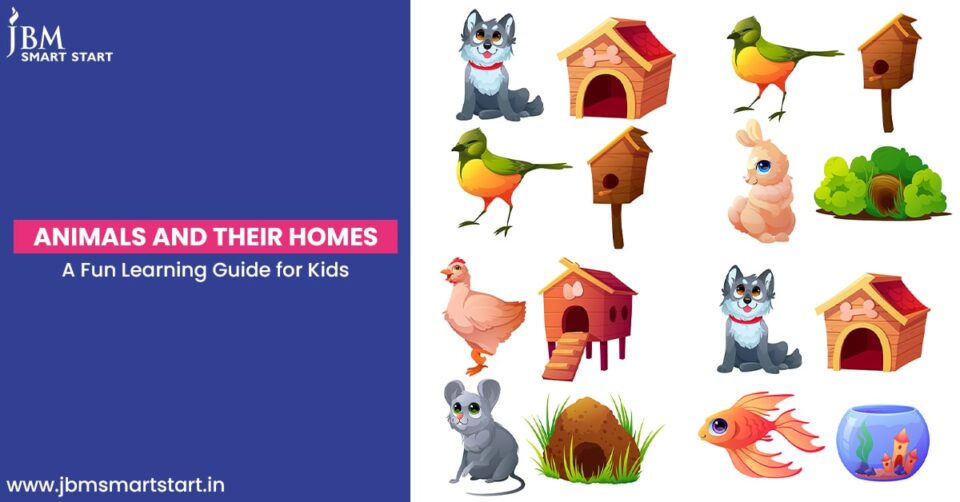
12 Simple Tips to Improve Your Child’s Listening Skills
March 30, 2025
Types of Animals: Fun Classification Guide for Kids
April 24, 2025Animals and Their Homes: A Fun Learning Guide for Kids
Have you ever wondered where animals go to sleep, raise their babies, or stay safe from predators? The world of animals and their homes is full of fascinating discoveries! From the forest dens of lions to the cosy kennels of pet dogs, every creature has a special space that suits its lifestyle.
In this blog, we’ll explore the amazing variety of shelters found in nature and those created by humans.
With the help of fun activities and a detailed list of animals and their homes, learning becomes a delightful journey for preschool kids. These animal homes for preschool learning help children understand the habitats of animals in both nature and at home.
Why Do Animals Need Homes? Understanding the Purpose of Animal Shelters
Just like humans, animals need homes for protection, rest, and raising their young. A home helps animals hide from predators, stay warm or cool depending on the weather, and find a safe space to sleep or store food.
For example, bees need hives to produce and protect honey, while foxes dig burrows to shelter from the cold.
Each type of animal has unique needs, and their homes reflect those survival strategies. This is why understanding animals and their homes gives us a glimpse into their lives and instincts.
Want to explore more? Read about the young ones of animals and their babies.
The Importance of Learning About Animal Homes for Kids
When you learn about animals and their home names, it’s not just about memorising facts. Instead, it’s about building empathy, curiosity, and awareness.
When children and young learners understand how animals survive in different environments, they begin to appreciate biodiversity and respect wildlife. It also enhances their observation skills and vocabulary.
Thus, with the help of a list of animals and their home names as well as engaging stories, this topic lays a strong foundation for nature education!
Also read: Why birds and animals are important for our planet.
Fun & Creative Ways to Teach Kids About Animals and Their Homes
1: Animal Matching Games: Pair Animals with Their Homes
You can create a game where kids or learners match animals with their respective homes with the help of cards or pictures.
For example, students will be required to pair a picture of a lion with its den or a dog with its kennel. It makes the learning process exciting and reinforces the animals and their homes name list visually.
2: Storytime Adventures: Teach Animal Homes Through Stories
Animal facts can be turned into engaging stories! You can narrate a tale about a beaver building its lodge or a bird protecting its nest from a storm.
This narrative approach helps learners remember and connect emotionally with each creature and its shelter. It helps them form a wild animals and their homes name list in their minds.
3: Art & Craft: Build Animal Homes Using Fun DIY Projects
You should let children create models of animal homes. For example, a paper hive, a shoebox stable, or a cotton-ball cave.
Art-based learning encourages creativity while offering knowledge of domestic animals and their homes, and wild animal shelters, with the help of hands-on activities.
List Of Domestic Animals and Their Homes
Here’s a closer look at common pets and farm animals, along with the places they live. This animals and their homes name list makes it easy and fun to understand their living spaces!
You may also like: Pet animal names with pictures for kids.
1: Dog – Kennel
A kennel provides dogs with a cosy space to rest, sleep, and feel secure, especially when they’re kept outdoors. It keeps them protected from harsh weather.
2: Cow – Shed
Cows stay in sheds that shield them from the sun and rain. These open-sided structures provide ventilation and comfort in rural environments.
3: Sheep – Pen
Pens are fenced areas that keep the sheep safe and allow shepherds to manage them easily. They offer protection from predators.
4: Rabbit – Hutch
A rabbit’s hutch is usually raised off the ground and built with wire and wood. It’s safe, airy, and keeps rabbits away from danger.
5: Goat – Barn or Shed
Goats stay in barns or sheds that are dry and ventilated. These homes help keep them warm in winter and shaded in summer.
6: Fish – Aquarium or Pond
Fish can live in artificial aquariums or natural ponds. Here, water quality and environment are essential for their survival.
7: Parrot – Cage
A parrot’s cage includes perches and toys. It must be spacious enough for flying short distances and mimicking their natural behaviour.
8: Pig – Sty
Sties are muddy, fenced areas that pigs love to roll around in. The mud helps them stay cool in hot weather.
9: Camel – Desert or Enclosure
Domesticated camels are often kept in open enclosures. However, wild ones roam in arid deserts where they’re well-adapted.
10: Bee – Hive
Bees build hives from wax where they store honey and raise their young. Hives are complex and super-organised living spaces.
11: Buffalo – Shed
Like cows, buffaloes stay in sheds for comfort and safety. They are large animals that need spacious, sturdy shelters.
12: Duck – Pond or Shelter
Ducks love water bodies like ponds, but also need nearby shelters to rest and stay safe from predators.
13: Chicken – Coop
A coop provides chickens with nesting boxes, roosting bars, and security from animals like foxes or cats.
14: Horse – Stable
Horses live in stables that offer space to stand, lie down, and be groomed. These are clean and dry structures.
15: Cat – House
Cats often live indoors but love creating little nooks and corners in the house to sleep and play.
16: Hamster – Cage
A hamster’s cage has tunnels, wheels, and bedding. It simulates the burrows they would naturally dig.
17: Donkey – Stable
Stables for donkeys are similar to horse stables but are built sturdier to match their strength and calm nature.
Also Read: Season Names In English And Hindi With Pictures
Wild Animals and Their Homes Name List
The wild is full of fascinating shelters. Here’s a detailed wild animals and their homes name list that showcases nature’s creativity.
1: Lion – Den
A lion’s den is usually a cave or thicket where the pride rests and hides its cubs from threats.
2: Elephant – Forest
Elephants don’t build homes. They roam across forests that offer shade, food, and water.
3: Fox – Burrow
Foxes dig burrows with multiple exits. These underground homes are cool, hidden, and great for raising pups.
4: Snake – Hole or Burrow
Snakes hide in holes, burrows, or under rocks. These spots help regulate their body temperature.
5: Deer – Forest
Deer live in forests where they graze in open meadows and rest under dense trees.
6: Crocodile – Riverbank or Wetlands
Crocodiles live near water. They create burrows along riverbanks to stay cool and rest.
7: Ant – Anthill
Anthills are incredible underground structures with tunnels and chambers. They are created entirely by ants.
8: Polar Bear – Ice Den
Female polar bears dig ice dens to hibernate and give birth. It offers them warmth in freezing regions.
9: Tiger – Cave
Tigers find caves or thick bushes to sleep during the day and hide from rivals.
10: Bear – Den or Cave
Bears hibernate in dens made in caves or hollow trees, especially during winter.
11: Bird – Nest
Birds weave nests from twigs and leaves. These are carefully placed by them in trees or buildings.
12: Monkey – Tree
Monkeys live in tall trees where they swing, eat, and sleep. They always remain close to their troops.
13: Penguin – Ice Burrow or Nest
Penguins make nests from pebbles or dig shallow burrows in icy regions.
14: Spider – Web
Spiders spin intricate webs to catch prey and rest safely.
15: Frog – Pond or Swamp
Frogs live in moist areas like ponds where they can lay eggs and hop freely.
16: Beaver – Lodge
Beavers build lodges with sticks and mud. These are watertight and have underwater entrances.
17: Squirrel – Drey
A squirrel’s drey is a ball-like nest built high in trees. It’s made of twigs and leaves.
18: Crab – Shell
Crabs live in shells or crevices near water. Some, like hermit crabs, borrow shells from others.
19: Rat – Hole
Rats make tunnels underground or live in walls. They build their nests from soft materials.
20: Eagle – Eyrie
Eagles build massive nests called eyries on cliff edges or tall trees to protect their chicks.
21: Hawk – Hawkery
A hawkery is a safe space high in trees or cliffs where hawks lay eggs and rear young.
Read More: Animals and Their Sounds: The Ultimate Guide for Kids and Curious Minds
Fun Facts About Animals and Their Homes
- Beavers use their teeth to cut down trees and build lodges.
- A single beehive can house over 50,000 bees.
- Some birds reuse and rebuild the same nest every year.
- Spiders have different web styles based on species.
Thus, when you explore animals and their homes, it reveals just how smart and resourceful nature is! With the help of a list of animals and their homes, kids can see the wonder in every creature’s shelter.
Read More: Different Types of Animals: A Fun and Simple Guide for Kids
Final Thoughts: Why Learning About Animal Homes Sparks Curiosity
From the forest to the farm, animals and their homes offer us a window into the way nature works.
You get to learn about many animals and their homes, from the cosy coops of chickens to the icy dens of polar bears!
You can use these animals and their homes’ names guide to inspire your child’s next discovery about the world around them.
At JBM Smart Start, we believe in making education engaging, memorable, and rooted in real-world understanding. Our curriculum introduces children to environmental awareness through interactive learning experiences.
Common Questions About Animals and Their Homes
Q1: What are the names of common animals and their homes?
Ans: Some common examples of animals and their homes include cow–shed, lion–den, rabbit–hutch, and fish–pond.
Q2: What is the difference between domestic and wild animals and their homes?
Ans: Domestic animals and their homes are often built by humans (kennels, stables), while wild animals and their homes are found or made in nature (caves, nests).
Q3: Why do animals need different types of homes?
Ans: Each animal’s habitat matches its survival needs, like temperature, predators, and food sources. Their homes are built in a way that fits into their way of life.
Q4: Can animals live in more than one type of home?
Ans: Yes, goats can live in sheds or barns, and snakes can use holes or burrows. Many animals adapt based on what’s available.
Q5: How do animals build or find their homes in nature?
Ans: Some animals, like foxes, choose to dig, and others, like birds, weave their nests. Other animals use natural structures to build their homes. Hence, every species has its unique way.




